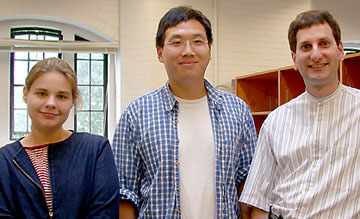
Mark Thachuk
Profile
Research and Teaching Interests
My research interests involve the study of the dynamics of chemical reactions/processes using mathematical and computational techniques. Currently, there are two main themes in my research group: studying collision-induced alignment of gas-phase ions, and examining the dissociation mechanism for gas-phase protein complexes
Collision-Induced Alignment
When ions or molecules move through a gas preferentially in one direction, they develop a preferred alignment. This motion can be induced by putting a charged ion in a bath gas with an external electric field, or by expanding a seed molecule in a molecular beam expansion, or even by injecting gas phase ions with high velocities directly into a bath gas. My group uses molecular dynamics simulations to model these kinds of experiments, with the goal of understanding the underlying mechanism for collision-induced alignment, and its dependence upon molecular parameters, such as charge and mass distribution.
Current projects include studying collision-induced alignment in non-linear ions, and determining whether this mechanism can be used to produce experimentally-tuned and isolated aligned molecules in the gas phase. In a similar vein, we are also examining the transition in the description of diffusion and mobility on moving from a Boltzmann regime (in which only uncorrelated binary collisions are important) to a hydrodynamic regime.
Dissocation of Gas-Phase Protein Complexes
Recent experiments examining the dissocation of non-covalent, gas-phase protein complex ions have discovered that under certain conditions, charge asymmetry can occur in the fragment ions. For example, a dimer of cytochrome c with a charge of 11+ yields predominantly on dissociation monomers with charges of 8+ and 3+ rather than the more symmetric 6+ and 5+ combination. It has been proposed that in the dissociation mechanism, one of the monomers in the complex unfolds, and this leads to the charge asymmetry. One active project involves using molecular dynamics simulations to examine this dissociation mechanism.
Beyond this though, we would like to develop simple models to treat this phenomenon, including extending reaction path models, and/or coarse-graining techniques to treat complex systems. One would like to capture the essential physics of this process without resorting to atomistic level simulations.

Contact
Curriculum Vitae
B. Sc., Western Ontario (1986); Ph.D., Waterloo (F.R.W. McCourt, 1991); Postdoctoral, Northwestern (G.C. Schatz, 1991-1993) and Queen's, Kingston (D.M. Wardlaw, 1993-1996).
